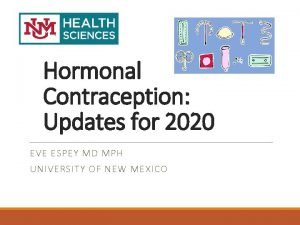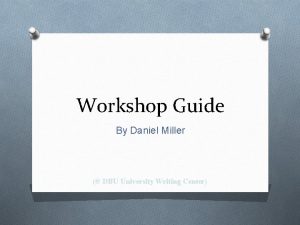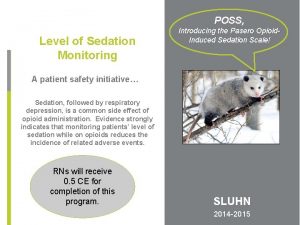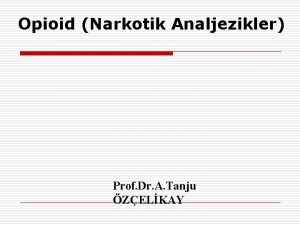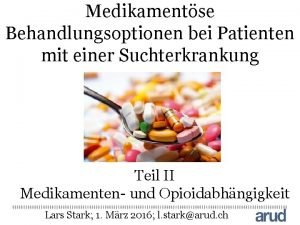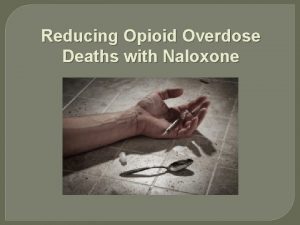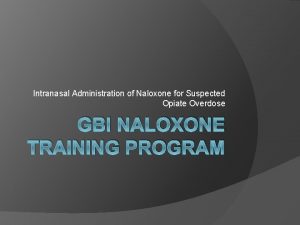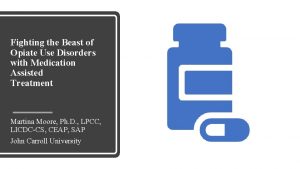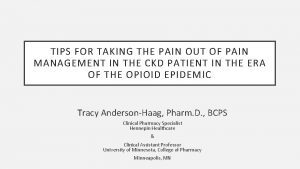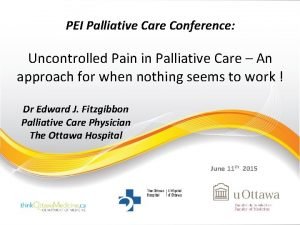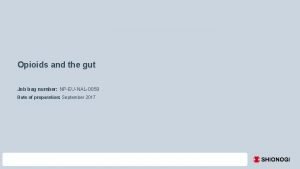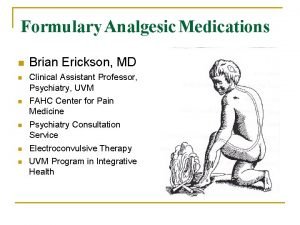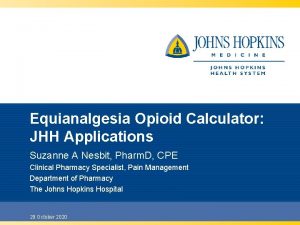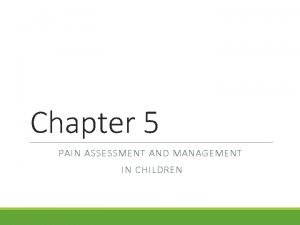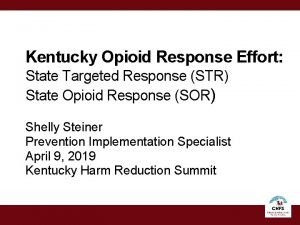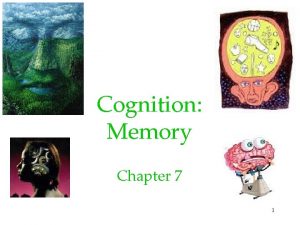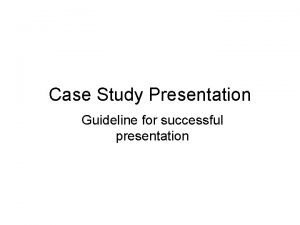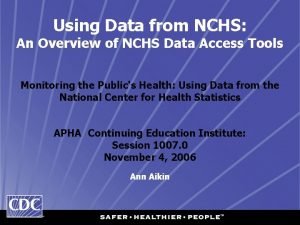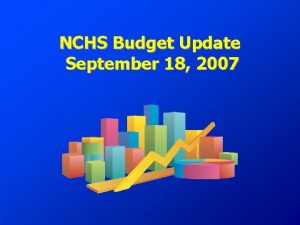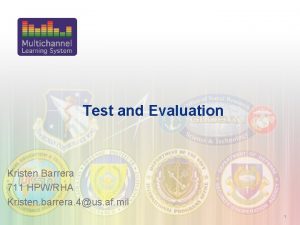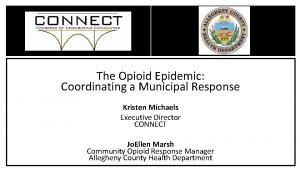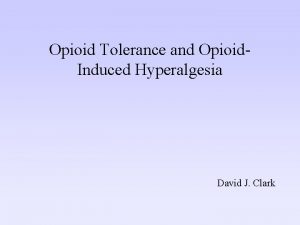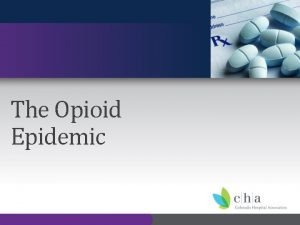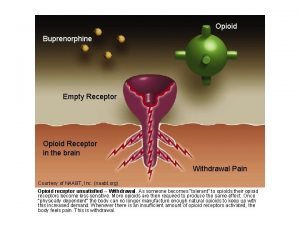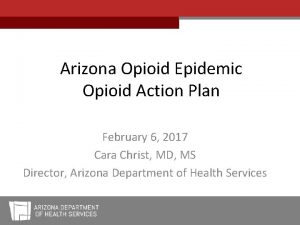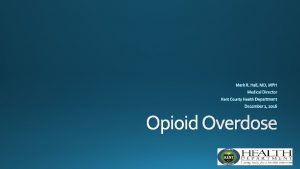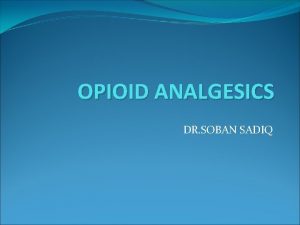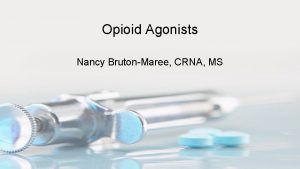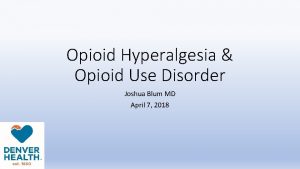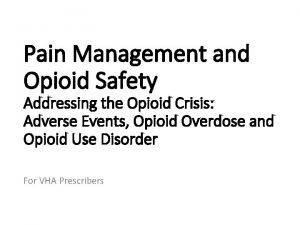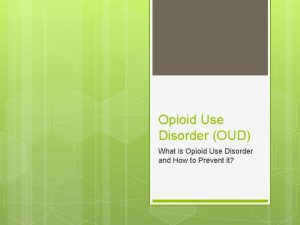NCHS OPIOID QUESTION EVALUATION STUDY Kristen Miller Ph


























- Slides: 26

NCHS OPIOID QUESTION EVALUATION STUDY Kristen Miller, Ph. D. Collaborating Center for Question Design and Evaluation Research, National Center for Health Statistics

OPIOID COMPARATIVE COGNITIVE INTERVIEWING STUDY • Topics: Opioid Use, Misuse, Impairment, Addiction • 140 Interviews (Additional 40 Spanish Interviews still to be conducted) • Regions: DC Metro; Lexington, KY; Mobile, AL; Seattle, WA; Boston, MA; Wichita, KS; El Paso, TX; Chicago, IL • Languages: Spanish, English

OPIOID COMPARATIVE COGNITIVE INTERVIEWING STUDY 1. What constructs are captured by individual questions? 2. Are they consistently captured across demographic groups in diverse socio-cultural contexts? Or other relevant respondent groups? 3. Assess the feasibility of asking opioid questions for face-to-face population-based household surveys • What topics are possible? • What are the data quality concerns?

at iv N e n e du at G ra ge ho ol Sc ee eg r D le ge G ED C ol S/ S H 65+ yrs H w lo 50 - 64 yrs le 30 - 49 yrs Be 29 18 15 19 25 36 38 42 56 Age C ol 18 - 29 yrs m e 1 7 6 36 74 Race/Ethnicity So er O th an er ic Am ia As k ac 9 Gender Bl hi te c pa ni Men W is Women H 68 72 SAMPLE CHARACTERISTICS Education

OPIOID-USE SAMPLE CHARACTERISTICS Usage Cause Chronic Condition Never 9% 9% Temporary 36% Source 11% 9% Injury 32% Surgery 46% Current, Extensive Previously, Extensive 26% Other 22% None 19% Legal 2% Illegal Both 79%

PRIMARY FINDINGS 1. Use 2. Misuse 3. Disorder

OPIOID-USE SCREENER QUESTIONS 1. These next questions are about the use of prescription pain relievers called opioids. When answering these questions, please do not include over-the-counter pain relievers such as aspirin, Tylenol, Advil, or Aleve. During the past 12 months, have you taken any opioid pain relievers prescribed by a doctor or dentist? Examples include hydrocodone, Vicodin, Norco, Lortab, oxycodone, Oxy. Contin, Percocet and Percodan. (13 errors) 2. Please look at the names and pictures of the pain relievers shown below. In the past 12 months, which, if any, of these pain relievers have you used? (8 errors)

NHIS ERROR PATTERNS 1. Respondents believed their medication, which is not listed as an example, is an opioid— and it’s not. (False positive) 2. Respondents did not realize their medication is an opioid. (False negative) 3. The examples limited respondents’ definition of what to include. (False negative) 4. Respondents forgot that they had taken an opioid months earlier. (False negative)

NSDUH 1. Respondents do not know the name of their opioid. (False negative) 2. Respondents mistook Tylenol 3 for regular Tylenol. (False positive)

CONCLUSIONS Neither question dramatically outperforms the other NHIS = more false negative pattern

RANDS OPIOID USE PREVALENCE RATE 35 30 25 20 15 10 5 0 NHIS NSDUH NHIS n=1302; NSDUH n=1344 *** p < 0. 001; Unweighted; Cohen’s h = 0. 177 NSDUH = 37. 9% NHIS = TBD

OPIOID MISUSE QUESTION The next question asks about using prescription pain relievers in any way a doctor did not direct you to use them. When you answer these questions, please think only about your use of the drug in any way a doctor did not direct you to use it, including: 1) Using it without a prescription of your own, 2) Using it in greater amounts, more often, or longer than you were told to take it, 3) Using it in any other way a doctor did not direct you to use it. Have you ever, even once, used any prescription pain reliever in any way a doctor did not direct you to use it?

FINDINGS Responses: 46 = ‘yes’ 72 = ‘no’ Of the 72 ‘no’ responses, 13 cases of false-negative reports. (Likely did not catch all) Concern of underestimation

When you answer these questions, please think only about your use of the drug in any way a doctor did not direct you to use it, including: • Using it without a prescription of your own • Using it in greater amounts, more often, or longer than you were told to take it • Using it in any other way a doctor did not direct you to use it • Have you ever, even once, used any prescription pain reliever in any way a doctor did not direct you to use it? Two Parts: “Am I taking without a MD’s prescription? ” If not, “Am I taking more than prescribed? ” One Question: Am I abusing? Yes “I’m an addict. ” No Yes “I don’t take opioids. ” “My pain was unbearable. ” “I’m a responsible user. ” “It was for recreation. ” No “I’ve never done these things. ”

When you answer these questions, please think only about your use of the drug in any way a doctor did not direct you to use it, including: • Using it without a prescription of your own • Using it in greater amounts, more often, or longer than you were told to take it • Using it in any other way a doctor did not direct you to use it • Have you ever, even once, used any prescription pain reliever in any way a doctor did not direct you to use it? Two Parts: “Am I taking without a MD’s prescription? ” If not, “Am I taking more than prescribed? ” One Question: Am I abusing? Justifications: Yes No “Same manner. ” “It all evens out. ” “It says as needed. ” “My daughter is a nurse practitioner. ” “I don’t take “I’m an addict. ” “It’s essentially the same purpose” opioids. ” “I’m a responsible user. ” Yes “My pain was unbearable. ” “It was for recreation. ” No “I’ve never done these things. ”

CURRENTLY PROPOSING 1. Did you ever take the medication more frequently or in higher doses than was prescribed? 2. Have you ever taken someone else’s opioid medication, that is, pain relievers not prescribed to you by your doctor?

DISORDER QUESTIONS • During the past 12 months, was there a month or more when you spent a lot of your time getting or using prescription pain relievers? • During the past 12 months, was there a month or more when you spent a lot of your time getting over the effects of the prescription pain relievers you used? • During the past 12 months, did you try to set limits on how often or how much prescription pain relievers you would use? [If yes] Were you able to keep to the limits you set, or did you often use prescription pain relievers more than you intended to? • During the past 12 months, did you need to use more prescription pain relievers than you used to in order to get the effect you wanted

DISORDER FINDINGS • Questions seen as asking about addiction (i. e. , whether they are or not) • Inability to establish causality

CURRENTLY PROPOSING • Reconsider the criteria for identifying ‘disorder’ in terms of what can be captured in household, population-based surveys • Very difficult to ask about opioid disorder • Interpretation: “Am I addicted? ” • Problems with causality • Clinical questions do not work in survey setting

SUMMARY OF FINDINGS 1) The ways in which respondents understood themselves in relationship to their use impacts how they interpret, process and ultimately respond to the opioid survey questions—particularly misuse and disorder questions 2) And, these understandings are informed by the social context in terms of: a. What they have heard about opioids and the epidemic b. Whether they know people impacted by the epidemic 3) These relationships impact the quality of data and can skew our understanding of the opioid epidemic– particularly for current, extensive opioid users

TYPES OF SELF-UNDERSTANDING USE SELF-UNDERSTSANDING CHARACTERISTICS Never-Not-Me Not a “pill person”; Doesn’t fill prescriptions; See addiction in others Uninformed No understanding of “opioid”; Unaware of opioid crisis Knowledgeable Understands self as being informed; Mindset that opioids are temporary; Does not refill; destroys medicine Avoider Not a “pill person”; Have taken, but decided didn’t like it; See addiction in others Uninformed No understanding of “opioid”; Lack knowledge of their own medicine Addicted Understands themselves as being addicted; “I’m hooked, ” “Oh yeah, I’m addicted” Responsible Understands themselves as having chronic, debilitating pain that requires opioids; Understands self as a responsible user; Receives opioids from a medical doctor, follows prescription (or rather, sees themselves as doing so) Recovered Addict • Understands self as always being an addict Not-Me • Views self as being over their addiction NEVER TEMPORARY CONTINUING PREVIOUSLY EXTENSIVE

NEVER USED SELFUNDERSTSANDING CHARACTERISTICS QUESTION RESPONSE USEAGE Not-Me Uninformed MISUSE, IMPAIR, DISORDER Not a “pill person” • Accurate • NA Doesn’t fill prescriptions See addiction in others No understanding of • False “yes” to • NA “opioid” NSDUH after seeing Unaware of opioid Tylenol 3 crisis

PREVIOUSLY, EXTENSIVELY USED SELFUNDERSTANDING CHARACTERISTICS QUESTION RESPONSE USEAGE Addict Recovered Addict • Personally understands • Accurate • opioid addiction • Understands self as always being an addict • Personally understands • Thinks of methadone as • opioid addiction a treatment, not an • Views self as being over opioid. their addiction MISUSE, IMPAIR, DISORDER Accurate

TEMPORARY USER SELF QUESTION RESPONSE CHARACTERISTICS USEAGE Knowledgeable Avoider Uninformed Understands self as being informed • Mindset that opioids are temporary Does not finish or refill prescription Destroys medicine Not a “pill person” • Have taken, but decided didn’t like it See addiction in others No understanding of “opioid” Lack knowledge of their own medicine Accurate MISUSE, IMPAIR, DISORDER • False Positives (Some Rs overly literal; paranoid about addiction) False “no” to NHIS; did not • False Negatives (Some Rs know medicine was an “I don’t abuse”; opioid justifications for misuse) • False “yes” to NSDUH after seeing Tylenol 3

CURRENT, EXTENSIVE SELF CHARACTERISTICS QUESTION RESPONSE USEAGE Addicted Responsible Understands themselves as being addicted “I’m hooked, ” “Oh yeah, I’m addicted” Accurate Understands themselves as having Accurate chronic, debilitating pain that requires opioids Understands self as a responsible user Receives opioids from a medical doctor, follows prescription (or rather, sees themselves as doing so) Recognizes addiction in others MISUSE, IMPAIR, DISORDER Accurate Misuse: Not always accurate= Strategies for understanding their misuse as “not misuse” Impairment: Ability to distinguish “pain” from “opioid side effects” is difficult Disorder: Not Accurate: = Interprets question as “Are you addicted? ”

NEXT STEPS 1. Conduct Spanish interviews 2. Continue analysis, complete report, write papers 3. Cognitive interviewing work with revised questions 4. More work with RANDS; looking at validity, adding misuse 5. Develop standardized, validated set of opioid-related survey questions
 Female tubal ligation
Female tubal ligation Nchs
Nchs Sweetened beverage
Sweetened beverage Eve espey
Eve espey Costas level of thinking
Costas level of thinking Miller indices of crystal planes
Miller indices of crystal planes Daniel miller arthur miller
Daniel miller arthur miller Medical plaza miller 131 miller street
Medical plaza miller 131 miller street Poss scale vs rass scale
Poss scale vs rass scale Aldolan
Aldolan Alprazolam äquivalenzdosis
Alprazolam äquivalenzdosis Opioid overdose
Opioid overdose Opioid overdose
Opioid overdose Opioid overdose
Opioid overdose Types of pain
Types of pain Mechanism of action of opioid analgesics
Mechanism of action of opioid analgesics What is pain
What is pain Opioid receptors location
Opioid receptors location Brian erickson md
Brian erickson md Suzanne nesbit
Suzanne nesbit Poker chip pain scale
Poker chip pain scale Kentucky opioid response effort
Kentucky opioid response effort Explicit memories
Explicit memories 44 thieves study evaluation
44 thieves study evaluation Citibank performance evaluation
Citibank performance evaluation Evaluation criteria for case study presentation
Evaluation criteria for case study presentation Question without question words
Question without question words



